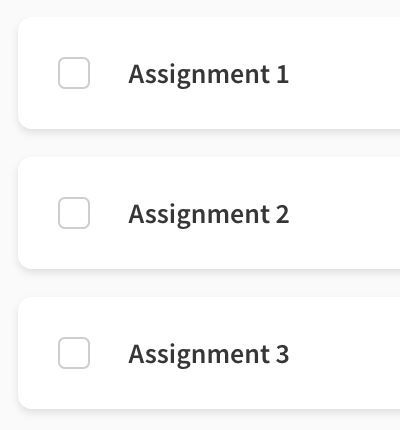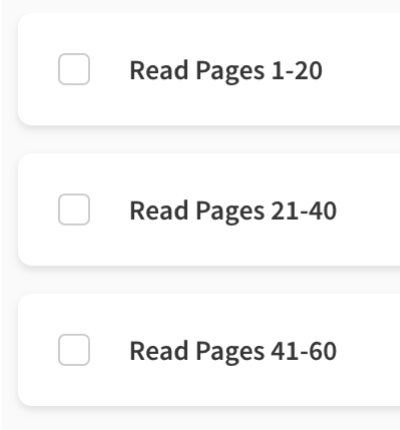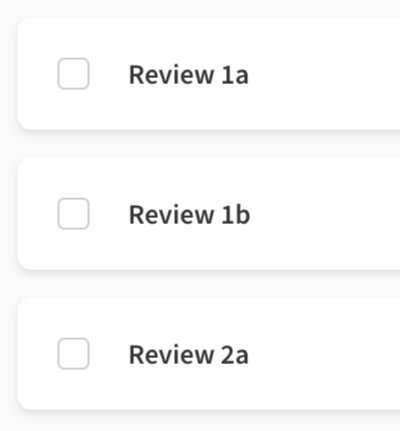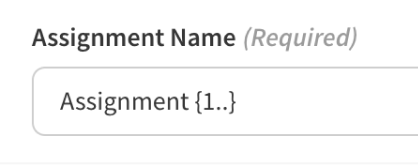Create Assignments with Patterns
When creating repeating assignments, you can use patterns to save a lot of time.
For example, with patterns you can easily name assignments with incrementing assignment numbers (Assignment 1, Assignment 2, Assignment 3, etc.) or divide a reading between multiple assignments (Read Pages 1-10, Read Pages 11-20, etc.).



How to Use Patterns
Begin creating repeating assignments as normal.
When filling in the Assignment Name and/or Assignment Description, type a pattern into the field. When you click Create Assignments, the patterned assignments will be created automatically. See below for example patterns.

What is a Pattern?
A pattern is made of two curly braces ({}) surrounding the range from which you want to produce assignments. There are 3 types of ranges:
- {X..} Incrementing range: You can use this pattern to increment numbers and letters on each assignment. X is the starting number or letter of the range. You can optionally add an end to the range such as {X..Y} where Y is the end of the range.
- {X-Y} Reading range: You can use this pattern to evenly divide a reading over multiple assignments. X is the first page of the reading assignment, and Y is the last page.
- {X,Y,Z} Word range: You can use this pattern to loop through each word separated by a comma. The range can contain any number of words.
Basic Pattern Examples
Incrementing Assignment Number
To add an incrementing number to each assignment, use a pattern like "{1..}" in the Assignment Name or Description. You can start incrementing from any number.
"Assignment {1..}" will yield:
- Assignment 1
- Assignment 2
- Assignment 3
- etc.
"Assignment {15..}" will yield:
- Assignment 15
- Assignment 16
- Assignment 17
- etc.
Reading Assignments
To divide reading ranges among the created assignments, use a pattern like "{1-60}" in the Assignment Name or Description.
"Read Pages {1-60}" spread among 10 assignments will yield:
- Read Pages 1-6
- Read Pages 7-12
- Read Pages 13-18
- (6 more assignments)
- Read Pages 55-60
"Read Pages {100-299}" spread among 4 assignments will yield:
- Read Pages 100-149
- Read Pages 150-199
- Read Pages 200-249
- Read Pages 250-299
Advanced Pattern Examples
Closed Ranges
You can use a range like "{1..}" to increment for each assignment, or you can use a closed range like "{1..3}" to increment through the end of the range.
"Study Group {1..3}" will yield:
- Study Group 1
- Study Group 2
- Study Group 3
Nested Repeats
You can use multiple incrementing patterns in the same field to create a "nested" pattern.
"Review {1..}{a..b}" will yield:
- Review 1a
- Review 1b
- Review 2a
- Review 2b
- etc.
Combining Incrementing and Reading Assignments
Using both pattern types works as expected. Notice these don't "nest" like above because reading ranges don't repeat.
"Assignment {1..}: Read {1-90}" spread among 15 assignments will yield:
- Assignment 1: Read 1-6
- Assignment 2: Read 7-12
- Assignment 3: Read 13-18
- (11 more assignments)
- Assignment 15: Read 85-90
Using Word Ranges
"Ch {1..6} Spelling Words - {Study,Quiz}" will yield:
- Ch 1 Spelling Words - Study
- Ch 1 Spelling Words - Quiz
- Ch 2 Spelling Words - Study
- Ch 2 Spelling Words - Quiz
- (7 more assignments)
- Ch 6 Spelling Words - Quiz
Nesting in Word Ranges
"{Lesson {1..4},Test 1,Lesson {5..8}, Test 2}" will yield:
- Lesson 1
- (2 more assignments)
- Lesson 4
- Test 1
- Lesson 5
- (2 more assignments)
- lesson 8
- Test 2
"{Lesson 1,Worksheet 1{a..g},Quiz 1}" will yield:
- Lesson 1
- Worksheet 1a
- Worksheet 1b
- (4 more assignments)
- Worksheet 1g
- Quiz 1
FAQs
What if I make a mistake?
If you need to delete or edit the assignments you just made, the easiest way is to:
- Search for assignments from the All tab
- Click Select All or select the errant assignments
- Confirm the correct assignments are selected
- Either bulk Edit, or Delete the assignments
How many assignments will be created?
The number of assignments that get created is determined either by your Assignment Name pattern, or by which days and weeks you select for repeating.
For example, if your repeating assignments are on Day 1 - Day 5, from Week 1 - Week 10, there would be 50 assignments. But if your pattern is "Lesson {1..10}" there would be only 10 assignments.
What if my pattern is shorter than the number of weeks and day?
If you create a pattern shorter than the number of assignments needed to fill the weeks and days you selected, you will end up with less assignments than expected.
For example, if you create a pattern for 3 days over 3 weeks the number of assignments you would expect is 9. However if the pattern you used when making those assignments was "Lesson {1..4}" you would only end up with 4 assignments.
- Lesson 1
- Lesson 2
- Lesson 3
- Lesson 4
What happens if there are more assignments than pages in a reading range?
If you divide a reading range like "Read pg. {1-3}" between 4 assignments, there are more assignments than there are pages to read. In this case, the latter assignments will have 0 pages assigned - rather than assigning fractional pages. For this example, the assignments would look like:
- Read pg. 1
- Read pg. 2
- Read pg. 3
- Read pg. (none)
Why is the last day's reading assignment smaller?
When the reading range doesn't divide evenly between assignments (see the example above), the earliest assignments will get more pages.